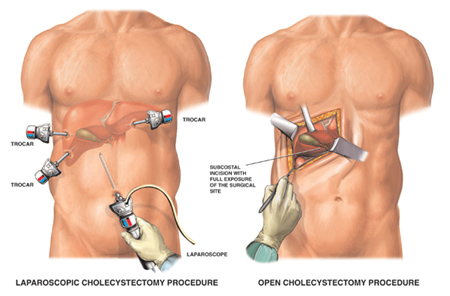LAPAROSCOPIC CHOLECYSTECTOMY

What is laparoscopic cholecystectomy ?
The surgery to remove the gallbladder is called a cholecystectomy (chol-e-cys-tec-to-my). The gallbladder is removed through a 5 to 8 inch long incision, or cut, in your abdomen. The cut is made just below your ribs on the right side and goes to just below your waist. This is called open cholecystectomy.
A less invasive way to remove the gallbladder is called laparoscopic cholecystectomy. This surgery uses a laparoscope (an instrument used to see the inside of your body) to remove the gallbladder. It is performed through several small incisions rather than through one large incision.
What is a laparoscope and how is it used to remove the gallbladder ?
A laparoscope is a small, thin tube that is put into your body through a tiny cut made just below your navel. Your surgeon can then see your gallbladder on a television screen and do the surgery with tools inserted in three other small cuts made in the right upper part of your abdomen. Your gallbladder is then taken out through one of the incisions.
Are there any benefits of laparoscopic cholecystectomy compared with open cholecystectomy? With laparoscopic cholecystectomy, you may return to work sooner, have less pain after surgery, and have a shorter hospital stay and a shorter recovery time. Surgery to remove the gallbladder with a laparoscope does not require that the muscles of your abdomen be cut, as they are in open surgery. The incision is much smaller, which makes recovery go quicker.
With laparoscopic cholecystectomy, you probably will only have to stay in the hospital overnight. With open cholecystectomy, you would have to stay in the hospital for about five days. Because the incisions are smaller with laparoscopic cholecystectomy, there isn’t as much pain after this operation as after open cholecystectomy.
What are the complications of surgery ?
- Damage to the bile duct can lead to leakage or even obstruction of bile flow. Laparotomy to drain or repair the bile duct may be necessary if this occurs. This is a serious problem but is rare with an incidence of less than 2%.
- Bleeding from blood vessels feeding the gall bladder or liver. This is usually controllable at the laparoscopy but may require further laparotomy to stop the bleeding. If the bleeding starts after the surgery has been completed, the patient may have to return to the operating theatre to stop the haemorrhage. Again this is a very rare complication.
- Damage to other organs or blood vessels. This is extremely rare and the incidence is minimised by using a special blunt tipped instrument to enter the abdominal cavity through the incision beneath the umbilicus.
- Gas embolism. This can occur when the CO2 which is being used to keep the abdomen inflated enters an open blood vessel and passes to the heart. This has never occurred in my experience.
- Pulmonary embolism. This occurs when clots form in the deep veins of the legs and pass up the veins to the lung blocking the flow of blood to the lungs. This has never occurred in my experience and should be less likely than with open surgery, as patients are in less pain and are moving about more freely on the day of surgery. Blood thinning injections and calf compressors are used during the surgery to help prevent this complication. Other medical problems such as allergic reactions, heart attacks, pneumonia and strokes can occur but are exceedingly rare.
- Wound infections are not uncommon especially in the umbilical wound, which can be contaminated by the bacteria in the gall bladder as it is removed. These are usually minor and respond to antibiotics but can be painful and a nuisance in the short term.
- Keloid scars. These are thickened scars to which some patients are prone. With the small incisions, scarring is minimal in most cases.
How long will I be in hospital and how long off work ?
Usually patients can go home 1-2 days postoperatively. One week off work is sufficient for sedentary workers. For those who do heavy lifting I advise four weeks off to allow the umbilical wound to settle and strengthen.











